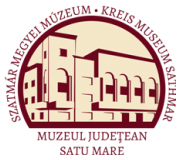Astaloş, Ciprian (szerk.): Satu Mare. Studii şi comunicări. Seria arheologie 28/1. (2012)
Bogdan Petru Niculică: Tre bronze sword of Costâna (Todireşti commune, Suceava county)
of the construction in which the sword of Măneuţi was found. Thus, valuable information was lost, fact that prevents us from having a clear and convincing image of a unique discovery in the east-Carpathian space. Naturally, we ask ourselves whether it could have been a possible tomb, with dimensions similar to those encountered in the case of other constructions of the cista type (as those appearing within the globular amphora and Komariv cultures in the Suceava Plateau9) or a construction with smaller dimensions, especially created, where only the bronze sword would have been deposited. We can also note the fact that the photograph at page 171 of the study discussed here, although lacking clarity, shows that we are in the area of the eroded bank of Suceava river. Our point of view is that the respective stone construction, where the sword of Măneuţi was discovered, was achieved in the meadow terrace of Suceava river. Therefore, the „case” was not built in the river, and the sword could not have been imbedded in the riverbed. This archaeological complex was brought to light by the side erosion of Suceava river, situation which we appreciate as being closer to reality. The observation that the place of discovery of the sword of Măneuţi is at about 300m upwards at the confluence of Pozen brook to Suceava river still remains valid10. Together with the swords of Costâna and Măneuţi, we also need to specify a fragment of sword blade, discovered in the site of Botoşana (Botoşana commune, Suceava county), in the basin of Soloneţ river, at 15 km west of Costâna. During the archeological excavations undertaken there, ceramic materials belonging to Komariv, Noua and Early Hallstatt (Grăniceşti group) were discovered11. Another discovery in Moldavia draws our attention: the cup-hilted bronze sword - Schalenknaufschwert - of Marvila - Dealul Cantonului (Corbasca commune, Bacău County), dated in the interval Ha A2-Ha B212. This sword also shows a ricasso, like the sword of Costâna. In the northeastern Carpathian space, there is an interesting concentration of bronze items in the Chernovtsy region (Ukraine), especially in Hliboca district, where there were signaled several fortifications, in which pottery of the Gáva-Holihrady type was pointed out13. Such is the case of the bronze deposit of Voloca (composed of a bronze cauldron in which seven celts had been laid), dated to Ha B-C, as well as several isolated items, among which two swords14. A discovery we need to take into account in our analysis is represented by the bronze sword handle of the Liptau type, belonging to the famous fighting knife with iron blade of Corni (Liteni commune, Suceava County)15. In 1956, at Todireşti - Halta CFR (Todireşti commune, Suceava County) - spot situated at only a few kilometers westwards of the place where the sword of Costâna was found - a bronze deposit with special features was found. The deposit was made of 12 hooked sickles, six bigger and six smaller16. As analogy, we can quote here the deposit of Dersca, Botoşani County, also composed of 12 hooked sickles17. Another deposit, dated to Hallstatt A, is the one discovered at the beginning of the 20th century, near Suceava18; in our view, the deposit was probably found in the area Şcheia - Silişte (Şcheia com.), situated in the western end of the city of Suceava19. The celt of Părhăuţi (Todireşti commune, Suceava County), discovered in the neighborhood of Părhăuţi village20, represents the closest discovery of a bronze item in relation to the Costâna area. This The bronze sword of Costând (Todireşti commune, Suceava county) 9 Dumitroaia 2000, 68-81, 127-156; Niculică 2005, 61-68; Niculică et al. 2005,69-86. 10 Batariuc 2003,167. 11 Teodor 1980,45-60, fig. 8/2 for the sword fragment; Bader 1991,165, no. 393, Taf. 56/393; Ignat 2000,69, no. 36/2, fig. 22/36/2. 12 Căpitanii/ Vulpe 1985,497-502; László 1994,148. 13 Maleev 1987, 86-101; Andronic 2008, 162-163; Zanoci 2011,117-152; Niculică 2011, 390. 14 Vojnarovskij/ Smirnova 1993, 183-190, fig. 1, 4; Andronic 2008, 174 and PI. 15 for bronze discoveries in the region of Chernovtsy. 15 Ignat 1981, 139-140, no. 2, fig. 4; Bader 1991, p. 138-139, no. 332, Taf. 35/332; Taf. 36/332; Ignat 2000, 102, no. 67, fig. 30. 16 Ignat 1981, 142, no. 12, fig. 7/4-5; Andronic 1997, 37, no. 21 C; Ignat 2000, 68, no. 34, fig. 21/34. 17 Petrescu-Dîmboviţa 1977,153, fig. 366/3. 18 Hänsel 2005, 285-299. 19 Research undertaken by B. P. Niculică at the Suceava County Direction of National Archives, 2011. 20 With the occasion of the excavation of a cellar, in the village core of Părhăuţi, a habitation level of Grăniceşti type was discovered, as containing several ceramic fragments, a spindle whorl and a head of clay stick. Cf. Niculică/ Ignătescu/ Boghian 1999,40, no. 5, fig. V/3,6. 239
